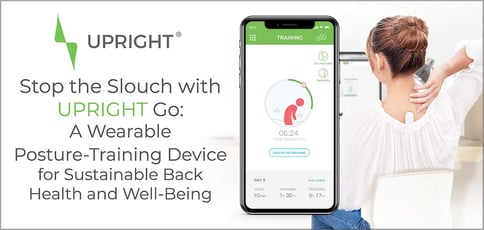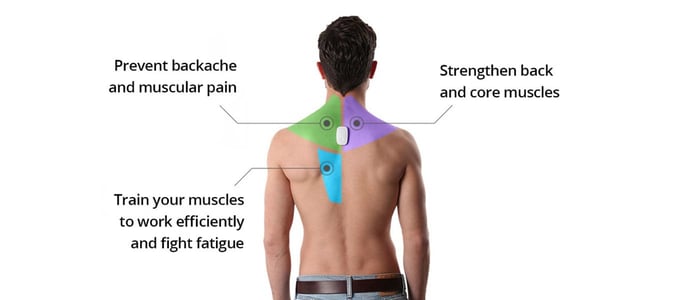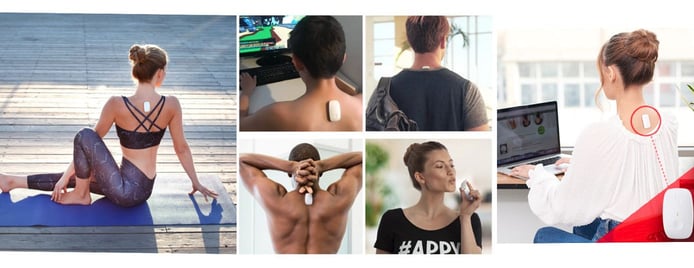
TL; DR: Upright, a provider of wearable posture monitoring and training devices, helps mitigate computer-related spinal problems. The device merges behavioral science with an innovative IoT concept to decrease pain and increase productivity. Now with a desktop companion to the mobile app, Upright Go users have even more opportunities to track and improve their posture.
If you’re staging a life-long, slumped-over rebellion in defiance of that teacher who always nagged you to sit up straight, you might want to think again. In a recent study by researchers at San Francisco State University, students who sat up straight were shown to perform better on simple math tests than those who did not.

Upright is an IoT device that improves posture using biofeedback.
And Ori Fruhauf, Co-Founder of Upright, said that’s not the only benefit. “Think about it: When you hold your body the right way, your blood flows better, and you can take in 30% more oxygen than when you are slouching,” he said. “This makes your brain and internal organs function better overall.”
From increased productivity and energy to lower stress and pain, Ori knows proper posture results in better health. At Upright, he’s helped develop Upright Go, an innovative IoT gadget used to monitor and correct posture. The device, which you attach to your upper back using medical-grade silicone adhesive, syncs with a free app to provide instant feedback and track progress.
Essentially, the device leverages the power of behavioral science to create positive habits that mitigate computer-related spinal problems. With a new desktop companion to the mobile app, Upright Go users now have additional opportunities to decrease back pain, increase productivity, and enhance overall well-being.
A Habit-Changing Posture Monitoring and Correction Device
When they launched Upright in 2014, Ori and Co-Founder Oded Cohen were on a mission to improve the health of people who spend hours each day hunched over computers and smartphones. Ori, an ex-fighter pilot, was suffering from back pain caused by the high g-forces placed on his spinal column while in flight. Oded, on the other hand, was inspired to create the tool to relieve his mother’s chronic back pain.
“She suffered from back pain for many years, and Oden tried every product on the market to help her,” Ori said. “The problem was, the products he found didn’t treat the cause of her pain — they just attempted to relieve what was already there.”
But what if, through a gentle reminder, you could correct your bad habits throughout the day, preventing that pain from appearing in the first place? Ori and Oded knew the concept was promising, so they created Upright Go to test it out.

Upright Go trains back muscles for increased strength and less pain.
The solution, which combines hardware, desktop software, and a mobile app, proved effective: In 2017, the posture tracker was named Health and Wellbeing Tech of the Year in the Wareable Tech Awards category.
“The hardware attaches to your upper back to monitor your spine movement; when it senses you’re hunched over, it will gently vibrate to remind you to correct your posture,” Ori said. “The reminder helps our brain quickly change the bad habit of slouching, which, over time, forms a long-term solution.”
The entire experience is tracked through an accompanying program the user can reference for real-time posture statistics, training data, and suggested goals.
Decrease Pain and Increase Productivity with Biofeedback Therapy
Biofeedback, defined loosely as a mind-body approach to changing a physiological function through electronic monitoring, is the driving methodology behind the Upright Go device. Ori said the technique has been used to improve posture since the early 1970s, though the instruments at the time weren’t always practical for everyday use.
“There have been many studies over the years demonstrating that a biofeedback device can help with improving posture,” Ori said. “We relied on established science to design a device that is small, easy to use, and comfortable to wear. We turned scientific evidence into a consumer product that people love to use throughout the day.”

The lightweight, easy-to-apply device is sleek enough to be worn almost anywhere.
To ensure a discreet look, Upright Go is lightweight and barely visible under clothes. “It’s very easy to use, and, importantly, it’s very low profile,” wrote one Amazon reviewer. “Even with tight-fitting ladies’ clothes, when you place it between your shoulder blades, there will be no visible outline.”
Users can turn to the app to track their time spent sitting or standing with proper posture versus slouching. The built-in, carefully paced training program — which includes daily goals — ensures that users won’t overdo it.
“If, on your first day of training, you’re upright for two hours, you may wake up sore the next day,” Ori said. “Our core muscles aren’t used to supporting our spines in the right posture, so we give you gradual options, 10 or 15 minutes at a time, for training purposes.”
The minutes gradually increase until your core muscles are strong enough to support your spine for extended periods.
Mitigate Computer-Related Spine Problems
It’s no secret that the wearable device market has exploded in the past 10 years or so. According to a 2018 report by CCS Insight, the trend will continue: Sales of these devices are expected to increase by an average of 20% per year for the next five years, with an estimated market value of $29 billion by 2022. In 2018 alone, Apple sold 16 million Apple Watches, with sales rising 60% compared with previous years.
Fitness trackers, such as Fitbit, Garmin, and Xiamoi, are helping users keep tabs on their heart rates, steps, and swim sessions. At night, wearables like the Oura Ring will provide you with all types of sleep-related information. But during work hours, Ori said, it’s Upright Go’s time to shine.
“There are many fitness trackers available to record your steps and calories during active times of the day, but few that track the 10 hours you sit in front of a computer,” he said. “That is exactly where we fit in, making Upright Go the perfect solution for anyone who wants to stay healthy and be more productive while at work, and ending their work day without any pain.”
To date, the Israel-based company has sold more than 200,000 units, with 90% of its customer base residing in the U.S. “Most of them are just people who spend a lot of time in front of their desk and understand the importance of good posture,” Ori said. “If you’re not interested in taking care of your body and your overall health, Upright Go probably isn’t a good fit for you.”
Now Available: A Desktop Companion to the Upright Mobile App
In terms of product development, the Upright team recently released a desktop app to complement the company’s existing mobile app. While it’s true that mobile devices are more popular than ever, workers still spend significant amounts of time on desktops, especially at the office.
“The desktop version provides the same experience as you have on your mobile app, but tailored to your office workspace,” Ori said. “It’s available now, and we’re pretty excited about it.”
Ori said that his customers generally feel the same about the product as a whole. The Upright Go has an average 4.5-star rating on the Apple Store and four stars on Amazon.
“We’ve designed a solution that people love and that actually gets results,” he said. “If you’re looking for something to help with back or neck pain and improve posture, we think you can find what you are looking for with the Upright Go.”
HostingAdvice.com is a free online resource that offers valuable content and comparison services to users. To keep this resource 100% free, we receive compensation from many of the offers listed on the site. Along with key review factors, this compensation may impact how and where products appear across the site (including, for example, the order in which they appear). HostingAdvice.com does not include the entire universe of available offers. Editorial opinions expressed on the site are strictly our own and are not provided, endorsed, or approved by advertisers.
Our site is committed to publishing independent, accurate content guided by strict editorial guidelines. Before articles and reviews are published on our site, they undergo a thorough review process performed by a team of independent editors and subject-matter experts to ensure the content’s accuracy, timeliness, and impartiality. Our editorial team is separate and independent of our site’s advertisers, and the opinions they express on our site are their own. To read more about our team members and their editorial backgrounds, please visit our site’s About page.

